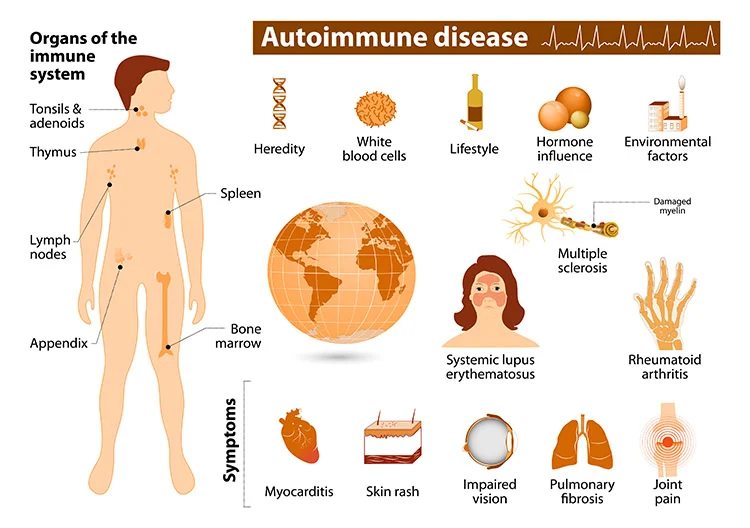Discover the causes of autoimmune diseases like lupus and Hashimoto’s thyroiditis and explore natural relief strategies such as elimination diets and lifestyle adjustments to reduce inflammation and manage symptoms.
Autoimmune Diseases Explained: Triggers, Symptoms, and Natural Relief
Your immune system is designed to protect you, but in autoimmune diseases, it becomes a case of “friendly fire”—attacking healthy cells instead of invaders. Over 80 known autoimmune conditions, including lupus, Hashimoto’s thyroiditis, and rheumatoid arthritis, affect 1 in 5 people globally, with women at higher risk. While genetics play a role, environmental triggers and lifestyle factors are key drivers. Let’s unravel the science behind autoimmune diseases and uncover practical, natural strategies to reclaim control.
Understanding Autoimmune Diseases: Why Your Immune System Misfires
Autoimmune diseases occur when the immune system mistakenly targets the body’s own tissues, causing chronic inflammation and damage. Common examples include:
- Lupus: Attacks skin, joints, and organs.
- Hashimoto’s thyroiditis: Destroys thyroid cells, leading to hypothyroidism.
- Rheumatoid arthritis: Targets joint linings, causing pain and deformity.
Key Challenge: Identifying the root cause of immune dysfunction.
Solution: A combination of genetic testing, symptom tracking, and lifestyle audits.
Autoimmune Disease Triggers: The Hidden Culprits
Challenge: Pinpointing Triggers in a Complex Web
Autoimmune flares are rarely caused by one factor. Instead, they arise from a “perfect storm” of genetic susceptibility and environmental exposures.
Solution: Addressing Common Triggers
1. Food Sensitivities:
- Gluten, dairy, and nightshades (e.g., tomatoes, peppers) often worsen inflammation.
- Action: Try an elimination diet (e.g., Autoimmune Protocol [AIP]) to identify triggers.
2. Chronic Stress:
- Stress hormones like cortisol disrupt immune balance.
- Action: Incorporate mindfulness, yoga, or deep breathing daily.
3. Toxin Exposure:
- Pesticides, plastics, and heavy metals (e.g., mercury) burden detox pathways.
- Action: Opt for organic produce and non-toxic household products.
4. Infections:
- Viruses like Epstein-Barr are linked to lupus and Hashimoto’s.
- Action: Support immunity with vitamin C, zinc, and probiotics.
Recognizing Symptoms: When Your Body Sounds the Alarm
Challenge: Overlapping and Misdiagnosed Symptoms
Autoimmune symptoms are often vague and vary widely:
– Fatigue, brain fog, joint pain, skin rashes, digestive issues.
Solution: Early Detection and Specialized Testing
- Blood tests: Check for antibodies (e.g., ANA for lupus, TPO antibodies for Hashimoto’s).
- Inflammation markers: CRP and ESR levels.
- Functional medicine approaches: Gut health analysis and food sensitivity panels.
Did You Know? It takes an average of 4.6 years and 5 doctors to get an autoimmune diagnosis.
The Role of Inflammation: Fueling the Fire
Challenge: Chronic Inflammation’s Domino Effect
Inflammation is both a cause and consequence of autoimmune activity, damaging tissues and perpetuating flares.
Solution: Anti-Inflammatory Diet and Lifestyle
- Foods to Embrace:
- Omega-3-rich foods (wild-caught salmon, chia seeds).
- Antioxidant-packed berries and leafy greens.
- Turmeric and ginger for natural anti-inflammatory effects.
- Foods to Avoid:
- Refined sugars, processed oils, and artificial additives.
Research Insight: A 2022 study in Nutrients found AIP diets reduced inflammation markers by 29% in rheumatoid arthritis patients.
Natural Relief Strategies: Beyond Medication
1. Elimination Diets: Reset Your Immune System
- How it works: Remove common trigger foods for 4–6 weeks, then reintroduce systematically.
- Success Story: A 2019 Frontiers in Immunology trial showed AIP improved fatigue and joint pain in 73% of Hashimoto’s patients.
2. Gut Healing: Repair the “Second Brain”
- 70% of immune cells reside in the gut.
- Action Steps:
– Take collagen or L-glutamine to repair the gut lining.
– Consume fermented foods (sauerkraut, kefir) for probiotics.
3. Stress Management: Calm the Immune Storm
- Chronic stress raises inflammatory cytokines.
- Action Steps:
– Practice daily meditation (apps like Calm or Headspace).
– Prioritize sleep (aim for 7–9 hours with a bedtime routine).
4. Movement and Exercise: Balance is Key
- Gentle activities like yoga or swimming reduce joint strain.
- Avoid overexertion, which can trigger flares.
5. Supplements: Targeted Support
- Vitamin D: Low levels are linked to higher autoimmune risk.
- Selenium: Critical for thyroid health in Hashimoto’s.
- Curcumin: Reduces joint swelling in rheumatoid arthritis.
Conclusion: Empowering Your Journey to Wellness
Living with an autoimmune disease can feel isolating, but understanding your triggers and adopting natural strategies can significantly improve quality of life. Whether you’re battling lupus flare-ups, Hashimoto’s fatigue, or rheumatoid arthritis pain, small changes—like tweaking your diet or prioritizing stress relief—can yield profound results.
Your Action Plan:
- Start a food/symptom journal to identify patterns.
- Experiment with one anti-inflammatory recipe this week.
- Consult a functional medicine practitioner for personalized care.
Remember: You’re not just managing symptoms—you’re rebuilding resilience.






